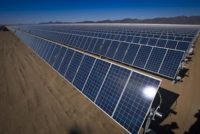

Egypt has prequalified 110 bidders for the construction of 2,000 MW of solar-photovoltaic and wind energy projects under the country’s first round of its new feed-in-tariff (FiT) program, launched in September 2014, after South Africa initiated its Renewable Energy Independent Power Producer Procurement Program.
A new report by the Egypt Solar Industry Association, "Energy Solar Market: FiT Program and Beyond," says at least 117 bidders submitted solar-PV and wind energy projects in the first round. The total exceeded by 50% the government’s target of 2,000 MW.
“The fact that the tender was twice oversubscribed is the biggest indicator of the FiT program’s success,” says the report, which also predicts increased importation of solar-PV panels while casting doubt on local capacity to manufacture the products quickly.
The bidders include solar-PV developers from the United Arab Emirates, France, Spain, Italy and India, according to Mohammed Nabil, senior associate at the Cairo-based law firm Sharkawy & Sarhan. The firm has been monitoring Egypt’s FiT plan since 2014 and works directly with the program’s prequalified bidders.
Of the prequalified solar-PV project bidders, 36 are for big, 50-MW-capacity projects, 12 projects are for 20-MW-capacity projects, and a few are for 25 MW or less, Nabil said.
“This makes the program appealing in terms of size, compared to Jordan, for example, which was the first to introduce solar FiTs in the region but received [only] 12 projects of 10- to 20-MW capacity,” he says.
Egypt, with an energy deficit of 5,000 MW to 6,000 MW, is experiencing an annual demand increase of 7%, according Wael El Nashar, president and CEO of Cairo-based Onera Systems. The company has been prequalified for a 50-MW solar-PV project under the FiT program and will work on the project’s engineering, logistics and project development.
The solar-PV expansion has attracted PV-panel manufacturers and suppliers; some already have in hand signed deals with the government to construct manufacturing plants to meet anticipated new demand.
“Some companies in Egypt are eyeing being the first movers and meeting the anticipated rise in demand ahead of the FiT projects,” the report says. Onera Systems has expressed interest in constructing a manufacturing plant that would produce 600 MW of solar cells a year.
Further, a new solar-PV-panel manufacturing line is planned by Arab Renewable Energy Co., a subsidiary of the Arab Organization for Industrialization of Egypt. It has signed a contract with Disctech FZCO, an affiliate of U.A.E.’s Z-One Holding, for a new production unit, according to the report.
“The production, with an initial capacity of 21 MW, will accommodate all types of PV modules, reaching an annual production capacity of 80 MW by the end of 2016,” says the Egypt Solar Industry Association report.
However, the association says contracts for setting up new PV-module manufacturing plants may not come on line early enough to accommodate the new solar-PV projects under the FiT scheme and developers may have to resort to importation “while locally sourcing the cabling, frames, mounting structures, electric work and construction.”
“SolarizEgypt, for example, is relying on Chinese panels and German inverters,” says Rana Alaa, the company’s co-founder.


Post a comment to this article
Report Abusive Comment